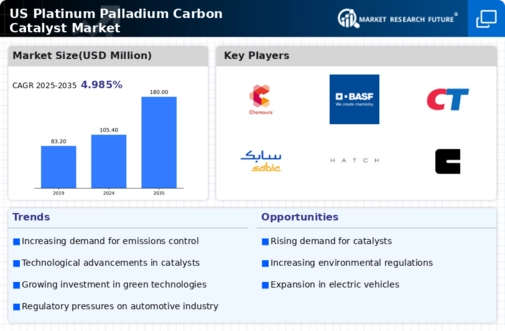The platinum palladium carbon catalyst market is characterized by a competitive landscape that is increasingly shaped by innovation, sustainability, and strategic partnerships. Key players such as Johnson Matthey (GB), BASF (DE), and Umicore (BE) are actively pursuing strategies that emphasize technological advancements and environmental responsibility. Johnson Matthey (GB) has positioned itself as a leader in sustainable catalyst solutions, focusing on reducing emissions and enhancing efficiency in catalytic processes. Meanwhile, BASF (DE) is leveraging its extensive research capabilities to develop next-generation catalysts that meet stringent regulatory requirements, thereby enhancing its market presence. Umicore (BE) is also making strides in this area, emphasizing the recycling of precious metals, which aligns with the growing demand for sustainable practices in the industry. Collectively, these strategies contribute to a dynamic competitive environment where innovation and sustainability are paramount.
In terms of business tactics, companies are increasingly localizing manufacturing and optimizing supply chains to enhance operational efficiency. The market structure appears moderately fragmented, with several key players exerting significant influence. This fragmentation allows for a diverse range of products and services, catering to various customer needs while fostering competition among established and emerging players.
In November 2025, Johnson Matthey (GB) announced a partnership with a leading automotive manufacturer to develop advanced catalytic converters that utilize their latest platinum palladium carbon catalyst technology. This collaboration is strategically important as it not only enhances Johnson Matthey's product offerings but also positions the company at the forefront of the automotive industry's shift towards greener technologies. The partnership is expected to yield significant advancements in emission reduction, aligning with global sustainability goals.
In October 2025, BASF (DE) unveiled a new production facility in the U.S. dedicated to the manufacturing of high-performance catalysts. This facility is expected to enhance BASF's capacity to meet the growing demand for platinum palladium carbon catalysts in various applications, particularly in the automotive sector. The establishment of this facility underscores BASF's commitment to regional expansion and its strategic focus on increasing production efficiency to better serve its customers.
In September 2025, Umicore (BE) launched a new recycling program aimed at recovering precious metals from spent catalysts. This initiative not only supports the circular economy but also reinforces Umicore's position as a leader in sustainable practices within the platinum palladium carbon catalyst market. The program is likely to attract environmentally conscious customers and enhance Umicore's reputation as a responsible player in the industry.
As of December 2025, current competitive trends indicate a strong emphasis on digitalization, sustainability, and the integration of AI technologies in catalyst development. Strategic alliances are increasingly shaping the landscape, allowing companies to pool resources and expertise to drive innovation. The competitive differentiation is expected to evolve from traditional price-based competition towards a focus on technological advancements, reliability in supply chains, and sustainable practices. This shift suggests that companies that prioritize innovation and sustainability will likely emerge as leaders in the platinum palladium carbon catalyst market.





















Leave a Comment